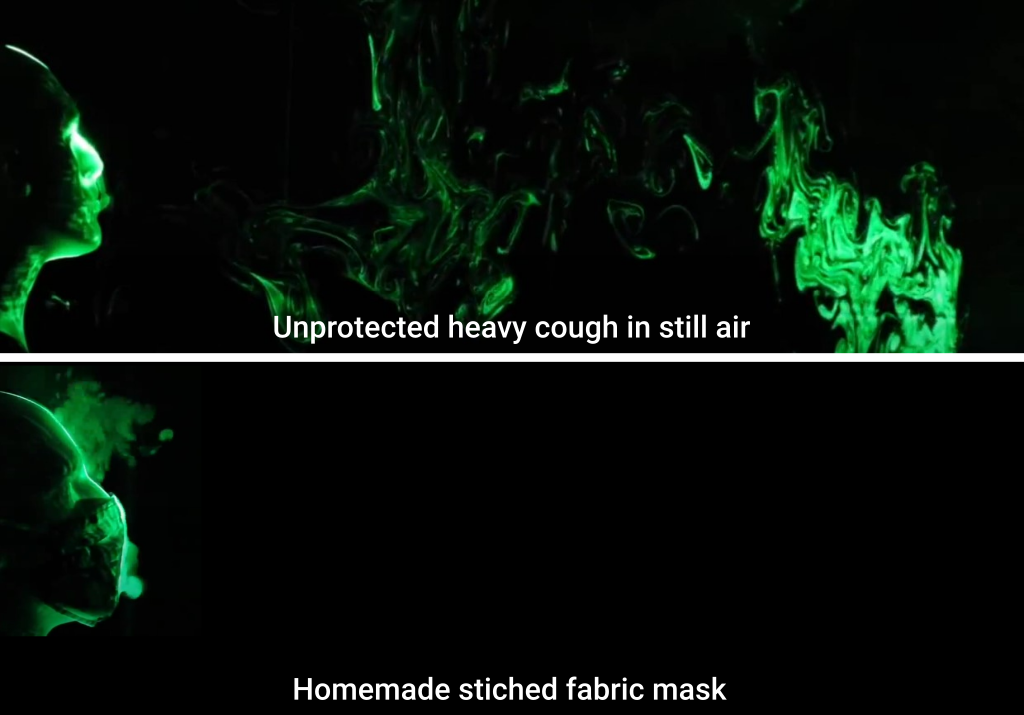 Check out the recent visualization study by Florida Atlantic University, Seeing is Believing: Effectiveness of Facemasks.
Check out the recent visualization study by Florida Atlantic University, Seeing is Believing: Effectiveness of Facemasks.The Airborne Debate
The evidence has been overwhelming, but the US CDC (Center for Disease Control) and WHO (World Health Organization) continue their reluctance to name airborne transmission of the SAR-CoV-2 virus as an important transmission path. Why??? People are dying in the US at an accelerated rate, and excluding airborne from consideration has hampered our ability to disrupt virus progression.
Research reports ranging from investigative studies to statistical analyses demonstrate airborne Covid-19 transmission as significant. Qian, et al [1] and co-workers studied 312 “outbreaks”, consisting of 3 or more related Covid-19 infections among 1245 individuals and found 80% of outbreaks occurred at home with 3 to 4 infections per outbreak. Although less than 20% of outbreaks occurred in larger gatherings, such as shopping venues, larger gathering outbreaks consisted of up to 8 to 9 transmission infections per outbreak. Basically, when an infectious person goes shopping, they infect 8 to 9 others, who then go home and infect 3 to 4 people. And that’s how 30 to 40 people are infected by a single person. Now, think of that person going out each day during their 14 day infectious period, infecting another 8 to 9 people who then go home where they infect family members, resulting in 400 to 500 infections caused by a single person. A more astounding result from the authors study of more than 7200 infection cases is that only 1 outbreak occurred outside! The outdoors outbreak is not part of the paper’s analysis because it only included 2 people.
Professor Mario Molina and colleagues released in-depth statistical analyses [2] in which disease transmission in China, Italy and the US were compared. You may recall Professor Molina’s name as he received a Nobel Prize for determining how Freons destroy the earth’s protective ozone layer. The researchers compared and contrasted similarities and differences (eg, mask wearing in China versus no masks in the US), and determine that the dominant mode of Covid-19 transmission is the airborne mechanism.
A recent article in The Harvard Gazette [3] reported on a talk by Harvard Medical Professor Edward Nardell, an international expert in airborne diseases such as tuberculosis. Professor Nardell stated that Covid-19 has all the hallmarks of an airborne disease. Furthermore, he remarked: “As people go indoors in hot weather and the rebreathed air fraction goes up, the risk of infection is quite dramatic.” That is, inadequate fresh air ventilation, inadequate indoor air filtration, and lack of other air cleaning (UVGI) are contributing the unending transmission of Covid-19 in indoor environments in the US.
Finally, 239 scientists signed a letter [4] addressed to the CDC and WHO declaring the airborne nature of Covid-19 transmission.
What could possibly be the downside to decreasing the probability of the airborne transmission path? Increased fresh air, increased air filtration and increased air sanitation all contribute to our overall improvement in health and well-being, and at a benefit-to-cost ratio that easily exceeds 10 to 1 without even considering the cost benefits related to decreasing Covid-19 cases.
And on the topic of masks...
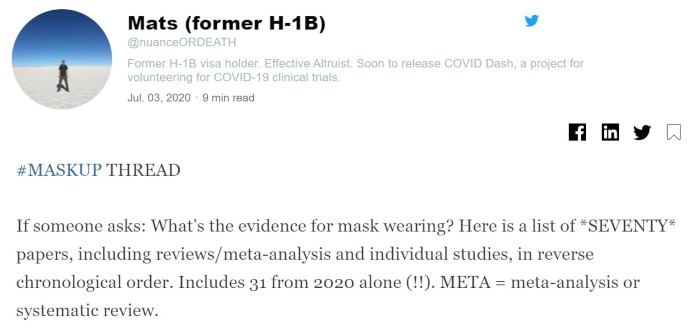 Check out this recent post containing links to 70 papers on efficacy of masks. TLDR: Wear a mask, they protect everyone.
Check out this recent post containing links to 70 papers on efficacy of masks. TLDR: Wear a mask, they protect everyone.Build Equinox Defining Paths Forward
Build Equinox has been at the forefront of fighting the transmission of Covid-19 from the beginning. Too many lives have been needlessly lost through confusion and inaction within the US, and unfortunately, we are still at the beginning of the pandemic. As horrifying as the current 3,000,000 infections with over 130,000 fatalities in the US sound, we are on a path toward 200,000,000 infections without effective control of the virus.
Ty recently made headlines in our local paper as they reported on his prediction of the current summer surge (“UI Professor: US Could Face Infection Tsunami”, July 2, 2020, News-Gazette). Ty’s Covid-19 disease transmission prediction modeling is unique because it is based on two simple parameters, a Social Distance Index obtained from the University of Maryland’s Transportation Institute, and a disease transmission efficiency parameter defined by our actions and local environment (eg, wearing face masks, distancing, improved ventilation and filtration, etc).
How bad will it get? Three weeks ago, Ty predicted the path we’re on, shown in Figure 1 below.
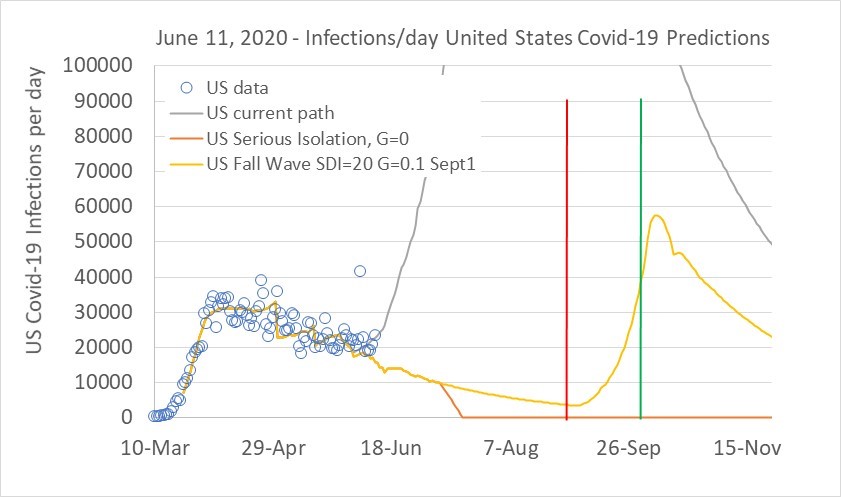 Figure 1: Predicted infection growth paths from June 11, 2020. Serious Isolation shuts the virus down in 3 weeks with perfect distancing, while Fall Wave showed a possible path that would decay virus transmission with an anticipated fall wave as schools and businesses open. Current path was predicted based on social distance index of 30 with a disease transmission efficiency of 0.22.
Figure 1: Predicted infection growth paths from June 11, 2020. Serious Isolation shuts the virus down in 3 weeks with perfect distancing, while Fall Wave showed a possible path that would decay virus transmission with an anticipated fall wave as schools and businesses open. Current path was predicted based on social distance index of 30 with a disease transmission efficiency of 0.22.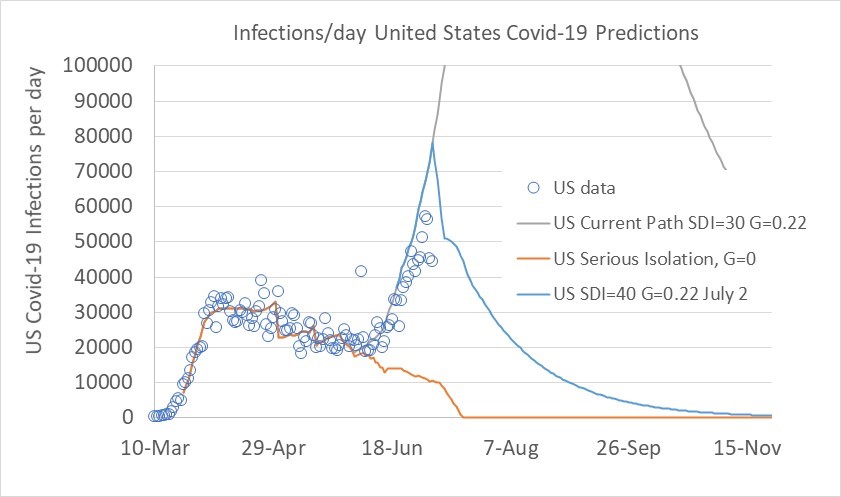 Figure 2: Three weeks after Figure 1, prediction unfortunately turns into reality as new infections per day data follows model predictions.
Figure 2: Three weeks after Figure 1, prediction unfortunately turns into reality as new infections per day data follows model predictions.Today, unfortunately, we have not done anything to improve our situation as Figure 2 shows current data and prediction trends. If we “distance” a bit more (increase SDI from 30 to 40), and reduce transmission efficiency a bit more (reduce below 20%), we can stop the accelerating growth of infection.
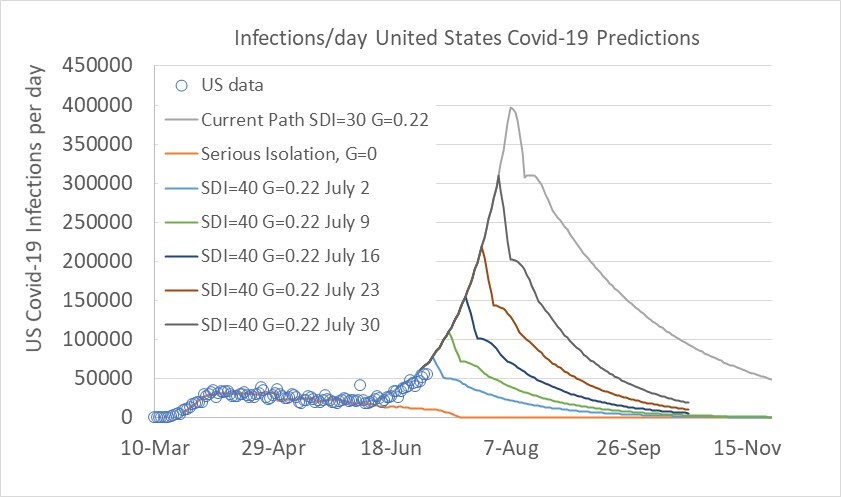 Figure 3: Increasing social distance index to 40 and decreasing transmission efficiency (by better face mask usage, increased fresh air, etc) during July can significantly impact disease progression, total infections, and fatalities.
Figure 3: Increasing social distance index to 40 and decreasing transmission efficiency (by better face mask usage, increased fresh air, etc) during July can significantly impact disease progression, total infections, and fatalities.Figure 3 shows the possible paths if these actions occur during July. If not, we are heading to 400,000 infections per day by the beginning of August with 25,000,000 total infections during the fall.
We have included two reports written by Ty describing the basis for the social distance modeling of Covid-19 (“Quantified Easing of Social Distancing Restrictions: Prediction of Covid-19 Disease Transmission Based on a Social Distancing Index”) and predicting the current summer surge (“400,000 Infection per Day”).
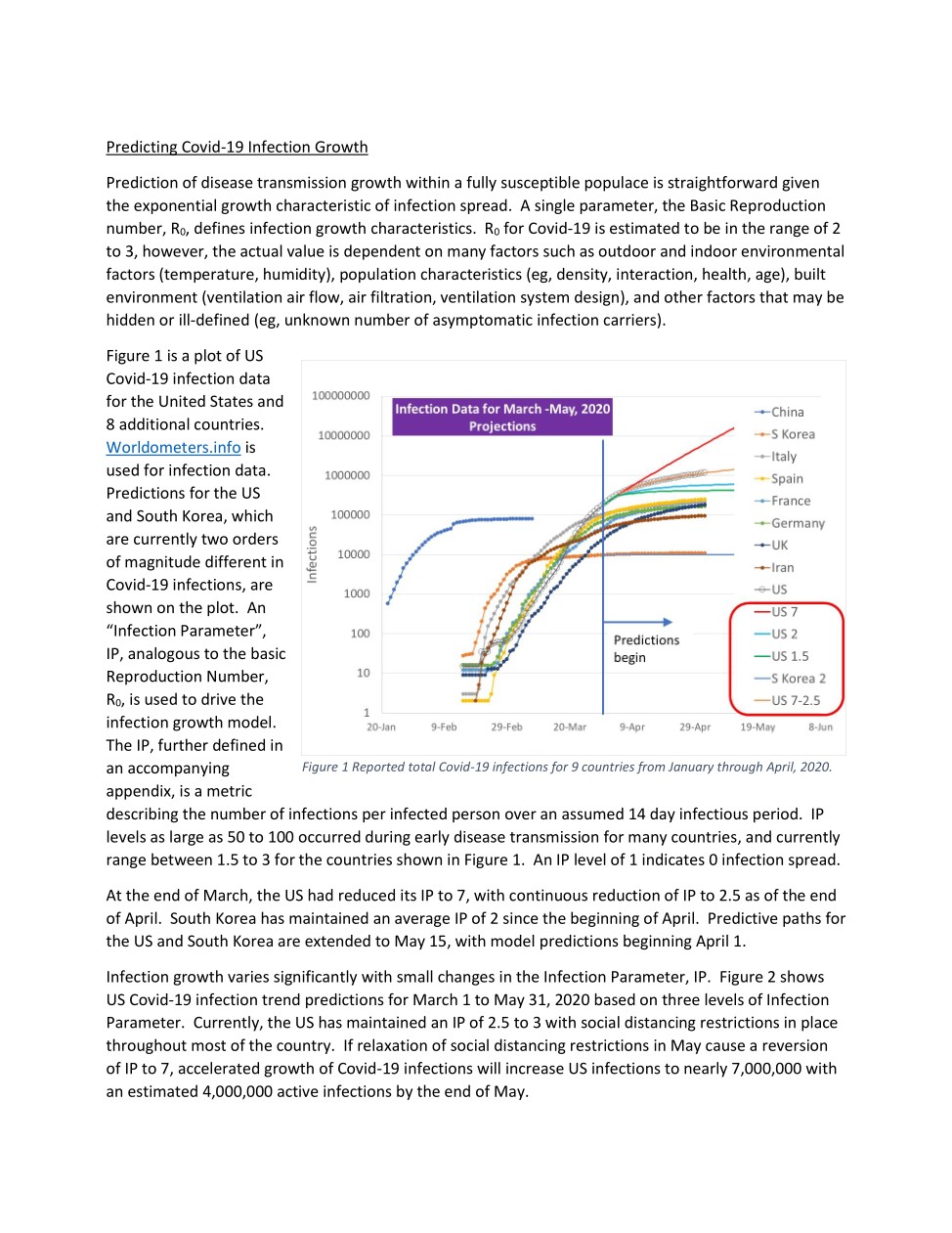
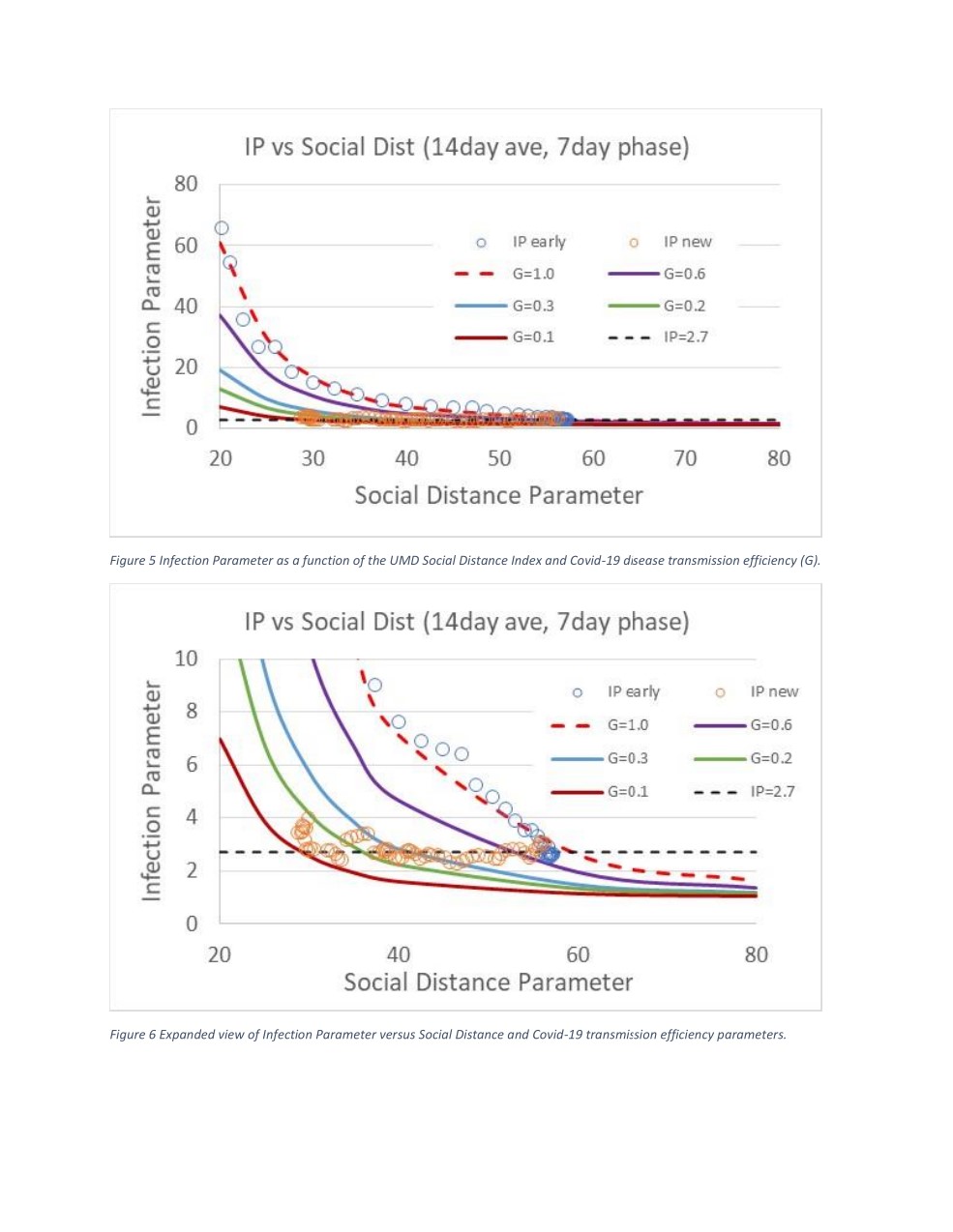
What Can We Do?
To reduce airborne transmission in the indoor environment, follow our guidelines! Increasing fresh air ventilation is the first step, ideally reducing indoor carbon dioxide concentration below 800ppm, which reduces the amount of “rebreathed” air as noted by Professor Nardell. Increase air filtration to at least MERV 11 and preferentially to MERV 13 or 16. And finally, consider adding UVGI to further sanitize the air. Our recent announcement of CERV-UV, a CERV2 integrated UVGI provides all three of these guidelines to protect your home.
For further background information, our previous newsletter articles are listed below:
Ty has been providing regular Covid-19 updates on Covid-19 disease progression, and efforts to curb its transmission in the US and internationally. Follow his reports on YouTube, and watch his isolation beard grow.
We are in this together, and together we defeat Covid-19 with coordinated, cooperative, and smart actions.
References
1. “Indoor transmission of SARS-CoV-2”, Qian, et al, medRxiv, Apr 7, 2020
2. “Identifying airborne transmission as the dominant route for the spread of COVID-19”, Prof Mario Molina et al; PNAS, V117#26, June 30, 2020
3. “Is air conditioning helping spread COVID in the South?”, Alvin Powell, The Harvard Gazette, June 29, 2020
4. “239 Experts with 1 Big Claim: The Coronvirus is Airborne”, A Mandavilli, NY Times, July 4, 2020























